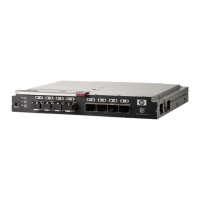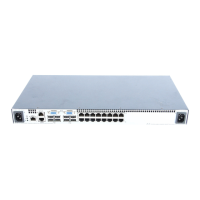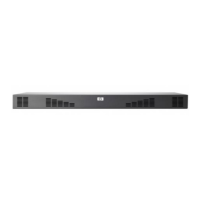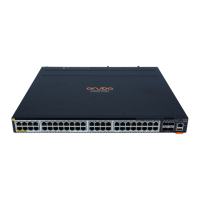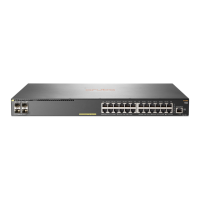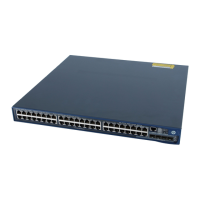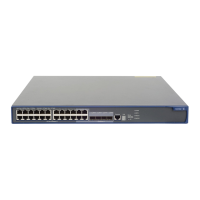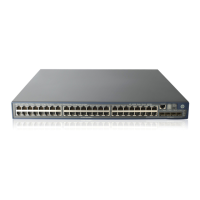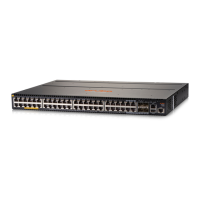
Do you have a question about the HP A7503 and is the answer not in the manual?
| Jumbo Frame Support | Yes |
|---|---|
| Manageable | Yes |
| Operating Temperature | 0°C to 45°C |
| MAC Address Table Size | 16K |
| Routing Protocol | OSPF, BGP, ISIS, RIP |
| Features | Quality of Service (QoS), VLAN |
| Operating Humidity | 10% to 90% (non-condensing) |
Covers switch model, card, and fabric hardware compatibility for IRF.
Explains the HP Intelligent Resilient Framework technology and its benefits.
Illustrates a typical IRF fabric deployment scenario with two switches.
Describes the two operational modes for a switch: standalone and IRF.
Details the roles of master and slave switches within an IRF fabric.
Explains the logical IRF ports and the physical ports used for inter-switch connections.
Covers scenarios of IRF fabric splitting and rejoining due to link failures.
Explains how member priority influences master election in an IRF fabric.
Details the physical connection requirements and media for establishing an IRF fabric.
Explains how IRF members exchange information to build a topology map.
Describes the process and rules for electing a master switch in an IRF fabric.
Covers ongoing management tasks like member ID assignment and topology maintenance.
Explains MAD mechanisms (LACP/BFD) to detect and handle IRF splits and collisions.
Outlines key parameters and methods for configuring an IRF fabric.
Details pre-configuration steps for member ID and priority in standalone mode.
Describes how to bind physical ports to logical IRF ports for fabric connectivity.
Explains how to save the current configuration to the startup configuration file.
Details the process of changing a switch's operating mode between standalone and IRF.
How to log in and manage the IRF fabric through its active or standby MPU.
How to assign a unique domain ID to an IRF fabric to prevent interference.
Steps to change the member ID of a switch within an IRF fabric.
How to set the priority for a member switch to influence master election.
Procedures for creating IRF ports and binding physical ports to them.
How to configure automatic reboot for member switches during IRF fabric merges.
How to add a description to a member switch for identification or management.
How to configure load sharing criteria for IRF links, globally or per port.
Manages how the IRF bridge MAC address is handled when the master switch changes.
Enables automatic synchronization of system software between the master and new member switches.
Configures a delay for reporting IRF link down events to prevent flapping.
Step-by-step guide to configure LACP MAD detection on aggregate interfaces.
Explains the BFD protocol's role and network setup for detecting multi-active collisions.
Step-by-step guide to configure BFD MAD detection using VLAN interfaces.
Allows specifying ports to remain active during IRF multi-active collision recovery.
Procedures for recovering an IRF fabric after a partition or failure.
A feature for quick IRF configuration recovery when MPUs fail.
Requirements before performing fast recovery, including saving configuration.
Step-by-step guide for fast recovery scenarios involving MPU corruption.
Commands and methods for viewing IRF fabric status, topology, and configurations.
Demonstrates configuring LACP MAD with two member switches, including network setup.
Notes on adding devices and using IRF2 for high availability with LACP MAD.
Step-by-step commands to configure LACP MAD for a two-member IRF fabric.
Guides on recovering IRF fabric when LACP MAD detects errors after link failure.
Demonstrates configuring BFD MAD with two member switches, covering network setup.
Notes on using IRF2 for high availability and MAD for collision detection with BFD.
Step-by-step commands to configure BFD MAD for a two-member IRF fabric.
Guides on recovering IRF fabric when BFD MAD detects errors after link failure.
Demonstrates configuring LACP MAD with four member switches, including network setup.
Notes on adding devices and using IRF2 for high availability with LACP MAD in a four-member setup.
Step-by-step commands to configure LACP MAD for a four-member IRF fabric.
Continues the LACP MAD setup for devices B and C in a four-member IRF fabric.
Completes the LACP MAD setup for devices C and D in the four-member IRF fabric.
Finalizes LACP MAD setup and configures the intermediate switch for MAD detection.
Guides on recovering IRF fabric when LACP MAD detects errors in a four-member setup.
Demonstrates configuring BFD MAD with four member switches, covering network setup.
Notes on using IRF2 for high availability and BFD MAD for collision detection in a four-member setup.
Step-by-step commands to configure BFD MAD for a four-member IRF fabric.
Continues the BFD MAD setup for devices B and C in a four-member IRF fabric.
Completes the BFD MAD setup for devices C and D in the four-member IRF fabric.
Configures Device E as an intermediate switch for BFD MAD packet forwarding.
Guides on recovering IRF fabric when BFD MAD detects errors in a four-member setup.
Notes on disconnecting IRF links and handling potential IP address collisions.
Step-by-step commands to switch switches from IRF mode back to standalone mode.
Details automatic reboots and notes on IP address collision after switching to standalone.
Provides information and requirements for contacting HP for technical support.
Encourages product registration for updates and enhancements.
Defines how commands, arguments, and syntax are presented in the document.
Explains how graphical user interface elements like window names and menus are formatted.
Defines symbols for warnings, cautions, important information, and notes.
Illustrates icons used to represent network devices like routers and switches.
Notes that port numbers used in examples are for illustration and may vary.

